Homage to Catalonia (Also Aragon and Valencia)
Lessons Learned During Nine Days in the Spain.
After my younger sister graduated from Georgetown with a major in Spanish and Linguistics, she taught English to Spanish businessmen in Madrid. I visited her a couple of times, and we travelled around the country guided by her local friends.
In Santiago de Compostela, I did shots of something called “burning grass” in a dark pub populated by old men in berets and some cats. I went topless in Ibiza. Later, Steve and I backpacked through Spain and Morocco. Starting off in Madrid, we went south to Granada, the Costa del Sol, and then took a boat across Gibraltar to Tangier.
When we were planning our trip to Spain, I chose cities and towns that I hadn’t already seen. We started off in Barcelona, which is the Catalonian region of the country. Then took a train to Zaragoza, which was layered with Roman, Medieval, Moorish, and Baroque buildings. If you say Zaragoza fast, it sort of sounds like its original name, Caesaraugusta. We drove to Valencia stopping a little town called Teruel, which had to be rebuilt after the civil war blew it to rubble. After two days in a great hotel in Valencia, we traveled on, swimming in the Mediterranean in the shadows of a castle that was used as a set for Game of Thrones.
It was a perfect trip. It was long enough to hit that sweet spot when you’ve completely forgotten about mundane worries, and are just starting to miss home. We covered a lot of territory— three regions of Spain, filled with their own culture and culinary specialities — but each place was only a two-hour train trip away from the next destination.
We considered an alternative trip that would have also started in Barcelona, and then we would have rented a convertible and explored the Pyrenees, Andorra, and France. However, we didn’t think we could squeeze in everything into nine days. We’ll save that trip for another year.
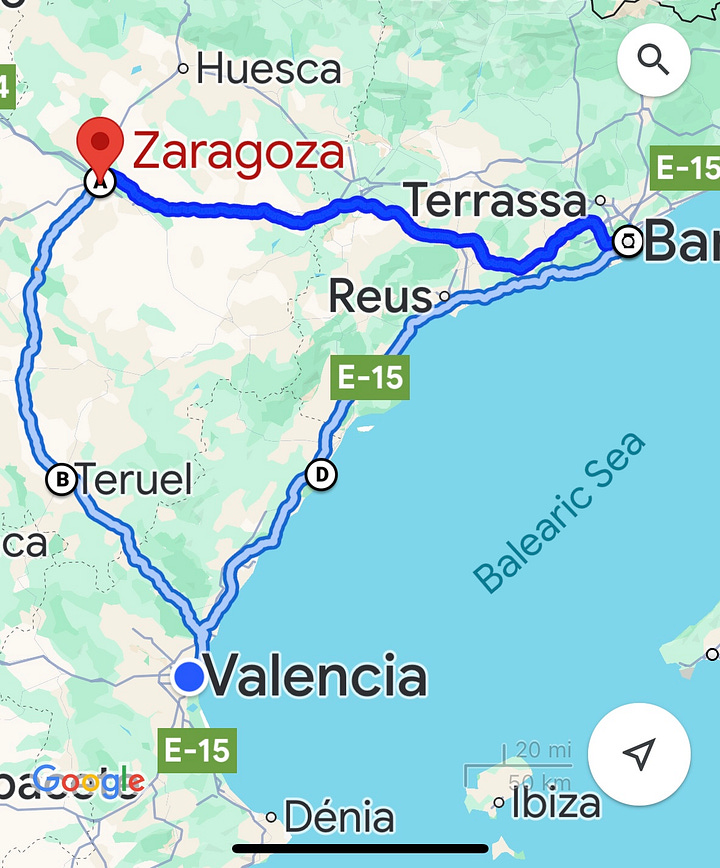

Where Were the Americans?
There was much in the news this summer about a Spanish backlash to American tourists, especially in Barcelona. We saw signs around the town explaining in English how to behave like a good tourist. But truthfully, we never saw many Americans on our whole trip — no loud tour bus people, no college backpackers, no honeymooning lovie-dovies.
Tangent: Read “Ugly American Sentiment Abroad” by Rick Steves.
Steve and I kept wondering where the Americans were. Maybe the Americans had already concluded their travels in June. Maybe young Americans aren’t backpacking anymore. The tourist backlash might have been aimed at the English laddies, who were concentrated in Madrid and in the islands. Maybe the anti-tourist rhetoric was really aimed at other foreigners, who were now living in their country. More on that in a minute.
Outside of Barcelona, our destinations were not well-known tourist spots, so it wasn’t surprising to not see Americans there. But Americans are missing out. Zaragoza and Valencia are both large cities filled with great history, museums, and food. We had some fried artichokes in Zaragoza that I’ll never forget.
Spain, especially in the smaller cities, was very affordable. We stayed in three and four star hotels for as little as $80 a night. Food was also inexpensive by New York standards. Steve and I would split three plates of tapas, which were $8 a plate. Wine and beer was less than $3 a glass. No tip or tax.
There’s no question that Europe is experiencing a major tourism boom. American dollars are boosting the economy and at the same time, creating new problems.

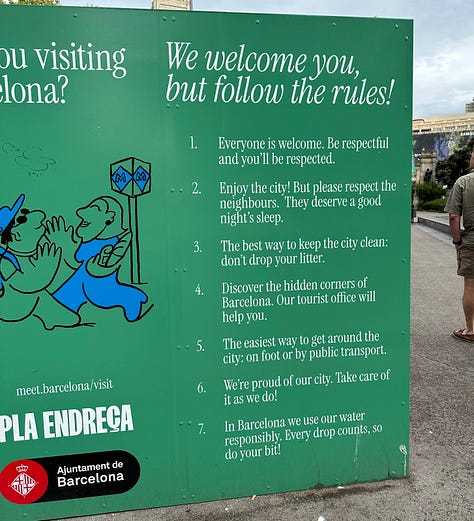

International Inequality and Immigration
While we didn’t see many American tourists, we did see a lot of new residents in Spain. Once we walked out of the touristy centers of town, we quickly entered graffiti-covered neighborhoods. Poverty in this country lurks just a few blocks from the Instagram-famous monuments and museums.
Walking across Barcelona to visit a famous park designed by Gaudi, we saw many clusters young men talking in French, maybe from Cameroon. We saw women in full burqas walking next to their husbands, who wore light Emerate soccer jerseys and shorts.
Tangent: I’m sorry, but if it’s 95 degrees and you’re making your wife wear a canvas bedsheet covering her face and body, then you should also have to wear a full bedsheet. There were several guys that I desperately wanted to kick in the shins.
Politicians have been cracking down on EU’s generous immigration policies, because of right-wing backlash. In Spain, there has been backlash around the country to those fleeing war and poverty in Africa and the Mid East, because the new groups aren’t assimilating. However, not all immigration is considered problematic. Even the far-right groups support the highly educated immigrants from Venezuela, who are filling tech positions.
The other tension is aimed at Americans, Russians, and Germans, who are buying up real estate at a bargain prices. You can get a beautiful apartment in a seaside town for $200,000, while a similar place down at the Jersey shore would go for a million.
The tourist backlash isn’t about Americans on a tour bus acting loud and obnoxious. It’s about rich folks moving to their country, buying up second homes or just staying for a long time, and driving up the price of real estate. People with remote jobs are relocating to cool spots around the world. From Aljareeza:
Soaring housing costs are at the heart of the protesters’ concerns. According to property website Idealista, rent prices in Barcelona have increased by 18 percent over the past year.
Over the past decade, rent rose by 68 percent and the cost of buying a house increased by 38 percent, making the city unliveable for locals. Apartments for tourists, including online rental sites, have strained the local housing market.
Spain isn’t a rich country. With all the money coming in from short-term and long-term tourists, they are getting priced out of everything from Taylor Swift tickets to a restaurant meal. They see how Americans spend money on luxury brands and posh hotels, while they are struggling for basics. The average salary in Spain is $42,900 per year. More than 80% of the population aged between 16 and 29 lives at home with their parents.
The Spanish are getting pushed out of their cities by richer countries and by immigration. And they’re not happy about it.
First Trip Without Kids
This trip was a big milestone for Steve and myself. It was our first trip without our children in 25 years. With Jonah to keep an eye on Ian (his epilepsy is always a concern), we left them here. We love our kids, but it was really great to travel without worrying about whether they were happy or not.
We’ve trained our kids to go to museums, because that’s what we like to do. But their attention span for museums is about two hours. On this trip, Steve and I got to read every sign and take audio tours. We were able to totally geek out without worrying about a revolution in our midst.
We could visit restaurants without kid-friendly options. Compared to other families with food sensitivities, our guys do pretty well. They’ll eat everything from sushi to spiced curries. But Steve and I will eat anything, anywhere, and it was very nice to not have to consider their interests at all.
Traveling with our boys as adults in most ways is easier than when they were kids. On one trip years ago, we had to pack an entire set of Thomas trains in a suitcase. But as adults, they are annoying in other ways. A couple of years ago, Jonah FaceTimed his girlfriend as we walked down the streets of Montreal, because he would have rather been traveling with her than with us.
This trip without kids was as monumental as the time when we were finally able to get rid of the diaper bag. We thought of our boys all time, commenting that one of them would have liked something or another. But it was really good to have a break, too.



Next Steps
Now back in Jersey and recovered from jet lag, I still feel great. For nine days, we walked all day in the sun. We ate fresh food. We saw new things and got smarter. I want to travel more regularly with the short time left before age and decrepitude sets in.
This fall, we have a couple of short trips to visit family in Florida and North Carolina. Necessary visits. In the early spring, we’re going to take Ian to see Universal Studios in California. Then, maybe another trip, just the two of us, to Ireland or Greece.
There are so many places to explore in the world, and I want to see them all.
I’ve took almost 600 pictures, which I’m in the process of cleaning up. Some pictures are on Instagram. Here are a few:
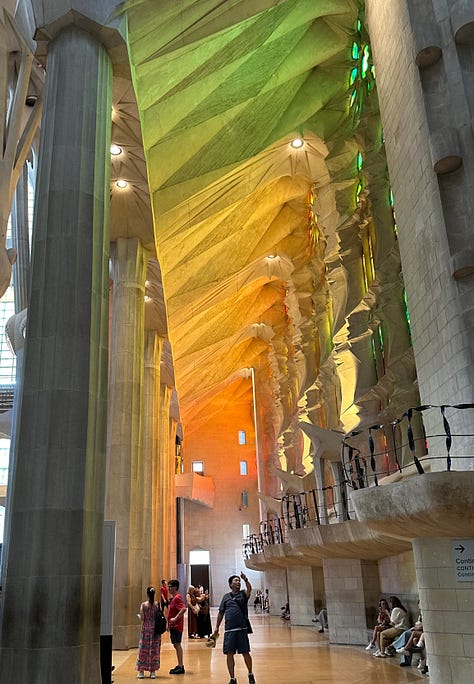

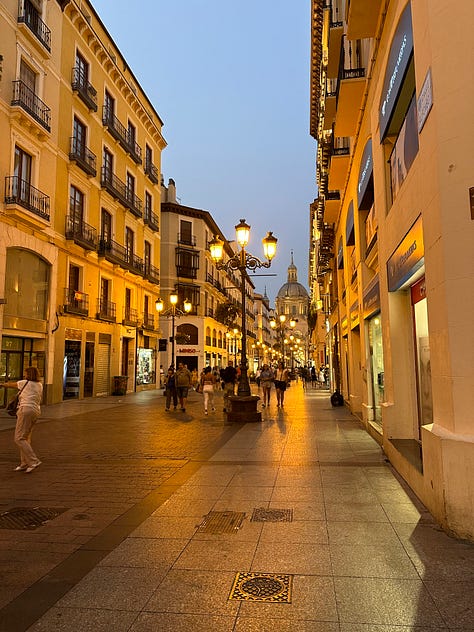
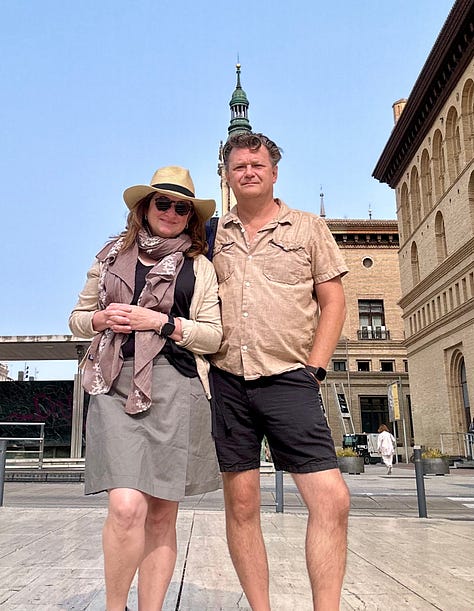
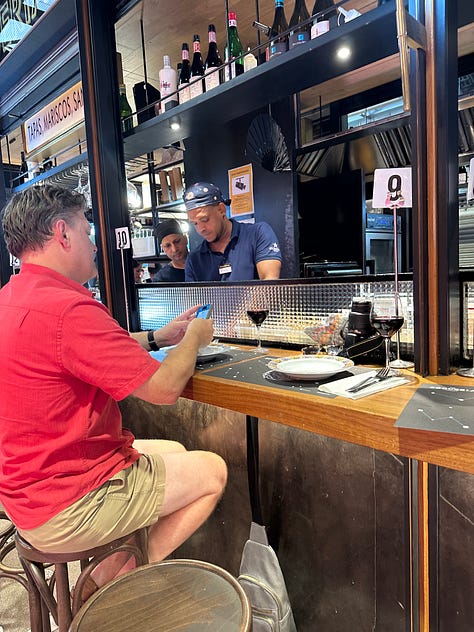
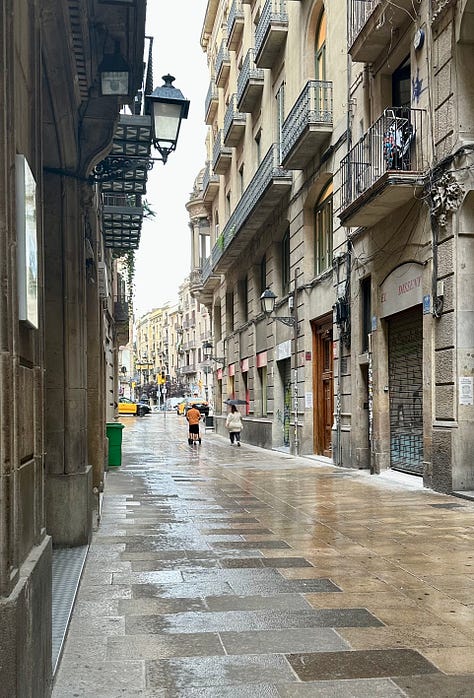








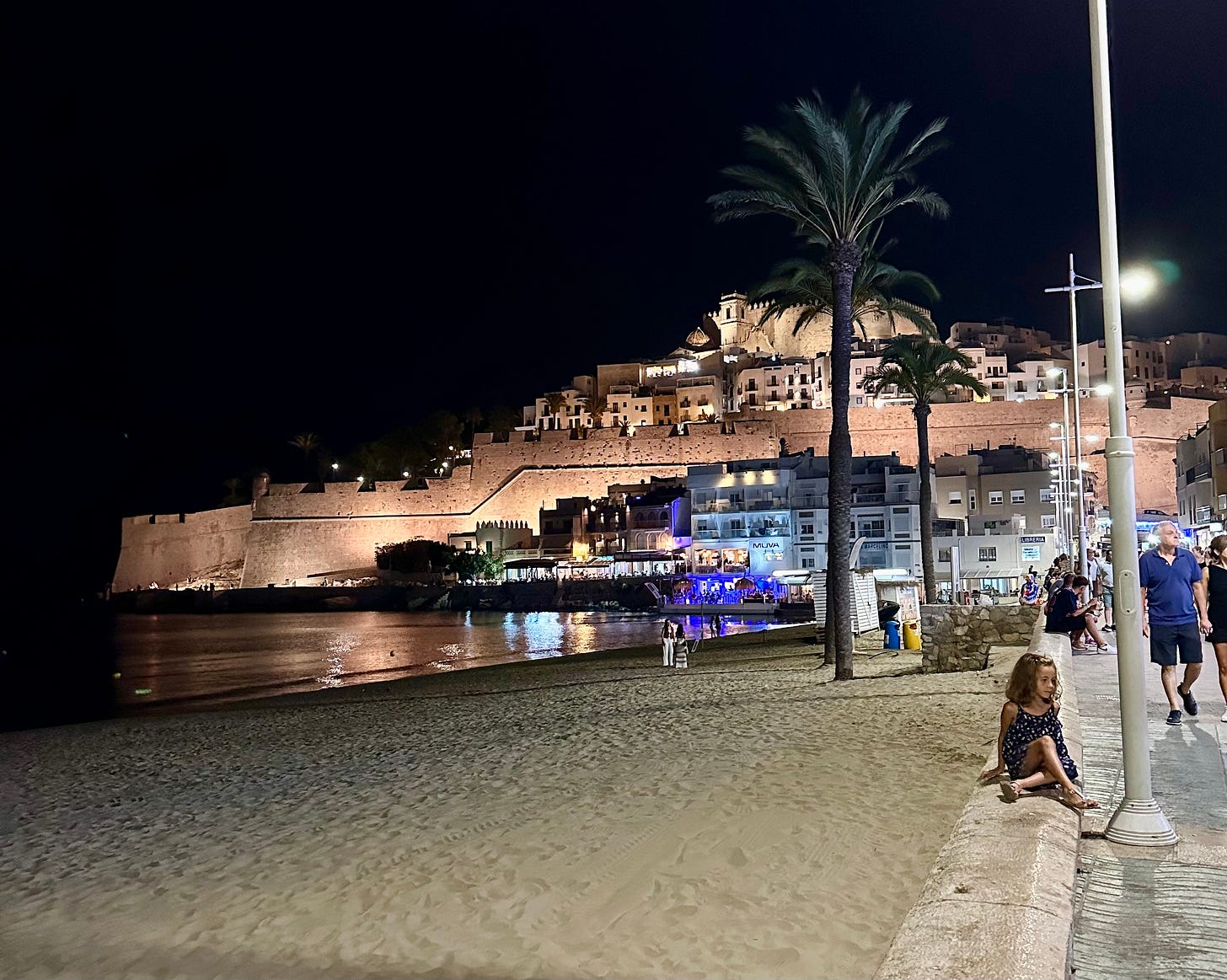
The tourist backlash is not particularly aimed at Americans - if you see a report in, say, Danish media focus will be on Northern European (and perhaps Asian) tourists, etc. Barcelona has been especially highlighted as tourism there has skyrocketed since the 1988 Olympics, but you will hear similar complaints in places like Amsterdam, Paris or Prague - and to a lesser degree, but still, even Copenhagen. (Denmark receives loads of German holiday makers who mostly stay in cottages on the west coast of Jutland during the summer and neither locals nor tourists make any complaints)
One issue is that tourists tend to concentrate on a few places in a city or destination, another that apartments are being air’bnb’ed, driving up rents and prices and hollowing out civic life. (British stag parties tend to descend on places with cheap alcohol and they are universally loathed). But if you avoid the obvious destinations and sights like the Sagrada Familia, the Louvre, Anne Frank Huis (Amsterdam has a great museum of Dutch Jewish life on the other side of town!) or the Charles Bridge and you stay in a hotel or hostel, things are much less tense.
And I think anyone who knows a bit about your backstory will say that it was a well-deserved holiday.